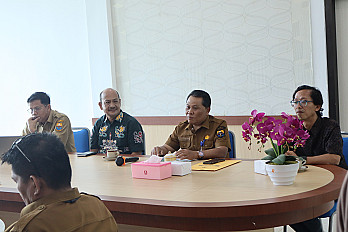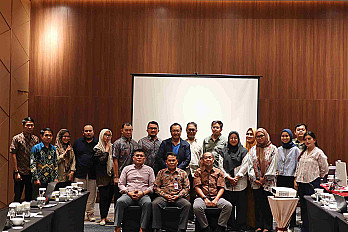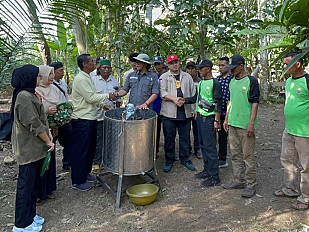News
228
Data Collection of Remote Indigenous Communities (KAT) in Jambi under the World Bank BioCF Grant Scheme: Building Synergy for Social and Environmental Justice

Portal BIOCF
Friday, 25 July 2025 Post 12:07 AM
Jambi – Jambi Province is one of the regions to receive a BioCarbon Fund Initiative for Sustainable Forest Landscapes (BioCF ISFL) grant from the World Bank, following East Kalimantan as the first province to receive similar funds. This program is a global effort to support landscape-based emission reduction, forest conservation, and the socio-economic empowerment of communities surrounding forest areas.
According to Ir. H. Sepdinal, M.E., Head of the SNPMU BioCF ISFL Jambi Province, all entities with legal standing and operating in forest areas have the opportunity to receive performance-based funding (Result-Based Payment or RBP). However, the position of Remote Indigenous Communities (KAT) in this scheme still requires special attention, especially since most lack formal legal standing or a Decree (SK) from the local government.
"KAT can be included in the performance group, but because they lack legal standing, funds cannot be disbursed directly to the community. They need to collaborate with area managers such as Forest Management Units (KPH) or National Parks (TN)," explained Sepdinal.
In such circumstances, the Forest Management Unit (FMU) or National Park (TN) is obligated to help fund and foster the activities of the KAT within their jurisdiction. Meanwhile, for KAT living outside forest areas, assistance opportunities are more focused on village-based socio-economic allocations.
World Bank Standards and Principles
Yunasri Basri, from the BioCF Safeguards Division of the Jambi Province ISFL, explained that BioCF implementation must adhere to the World Bank's Environmental and Social Standards, which include socio-environmental impact assessments, biodiversity conservation, protection of indigenous communities, and preservation of cultural heritage.
Specifically for KAT, the national legal basis used is Ministerial Regulation No. 9 of 2012 and Ministerial Regulation No. 12 of 2015, which classify KAT into three categories:
Category 1: nomadic hunter-gatherer communities with minimal interaction with the outside world.
Category 2: shifting cultivators with limited interaction with the surrounding community.
Category 3: settled communities engaged in farming, fishing, or gardening.
However, various obstacles are still encountered in the field, ranging from a lack of accurate data, the absence of a clear benefit distribution scheme, to uncertainty regarding management areas.
Voices from the Regions: Conditions of Indigenous Peoples (KAT) in Regencies and Cities
Each regency in Jambi reports varying conditions for Indigenous Peoples (KAT).
Merangin Regency recorded 13 Indigenous Peoples (KAT) groups (Suku Anak Dalam/SAD) with a total of 1,267 people. Most still live in and around forest areas, with low levels of legality.
Sarolangun Regency has 507 Indigenous Peoples (KAT) families, most of whom are settled and have population data. In fact, some SAD members have worked in plantations, and some are members of the Indonesian National Armed Forces (TNI) and the Indonesian National Police (Polri).
Tebo Regency has 1,146 Indigenous Peoples (KAT) spread across nine villages. There is also the Talang Mamak Tribe, which has settled and is categorized as Category 3.
Sungai Penuh City and Kerinci Regency are still in the process of clarifying their status, as the majority of their indigenous people are farmers around Kerinci Seblat National Park (TNKS).
Batanghari, West Tanjung Jabung, and East Tanjung Jabung Regencies also have indigenous groups with varying circumstances, from those still nomadic to those who are economically independent.
In Muaro Jambi Regency, 2,473 indigenous people are reported to have settled and have permanent jobs.
In addition to the government, NGOs such as KKI WARSI, Pundi Sumatera, and Gita Buana play an active role in assisting these communities, both in economic empowerment and advocacy for indigenous peoples' rights.
The Role of the Social Services Agency: Data Guardian and Primary Facilitator
Almost all discussion participants emphasized that the Social Services Agency (Dinsos) is the primary data guardian for the KAT (Regional and Indigenous Peoples) in each district/city. Dinsos is responsible for data collection, categorization, and coordination with the Forest Management Unit (KPH), National Parks, and other supporting institutions.
Yunasri Basri emphasized,
"The SNPMU only accepts data provided by Dinsos. We have no authority to intervene or change that data."
The Jambi Provincial Social Services Agency will be responsible for coordinating all data from districts/cities, while the Regency Social Services Agency will be the field implementer who interacts directly with the community.
Challenges and Hopes
From the various discussions, several key challenges emerged:
The lack of official legality (Governor's/Regent's Decree) for most KAT groups.
Data is incomplete and has not been separated by category and location (inside or outside forest areas).
Limited livelihood opportunities for KAT, especially in areas that are already entirely forested.
However, amid these challenges, various inspiring stories have emerged. Several SAD members in Merangin have continued their education to university. In Tebo, KAT Talang Mamak has begun collaborating with companies and NGOs to protect forests and develop economic enterprises.
Moving Forward: Synergy and Data Validation
This coordination meeting emphasized that the categorization of indigenous peoples (KAT) remains guided by Ministerial Regulation No. 9 of 2012, and that the Social Services Agency is the primary data provider. Data needs to be updated and separated by category and residential location.
Furthermore, follow-up meetings will be held involving the Forest Management Units (KPH) and National Parks in each district to ensure the validation of KAT data. It is hoped that all KAT in Jambi Province will be properly recorded and receive equitable and sustainable benefits from the BioCF program.
Conclusion
The initiative to collect data and strengthen the role of KAT in the BioCF ISFL program is not only about distributing aid, but also about ensuring that indigenous communities and forest communities have an equal place in sustainable development.
Through collaboration between the government, conservation institutions, and civil society organizations, Jambi strives to make the BioCF program not just an environmental project, but also a tangible manifestation of social justice for indigenous communities who have long protected the forests.
According to Ir. H. Sepdinal, M.E., Head of the SNPMU BioCF ISFL Jambi Province, all entities with legal standing and operating in forest areas have the opportunity to receive performance-based funding (Result-Based Payment or RBP). However, the position of Remote Indigenous Communities (KAT) in this scheme still requires special attention, especially since most lack formal legal standing or a Decree (SK) from the local government.
"KAT can be included in the performance group, but because they lack legal standing, funds cannot be disbursed directly to the community. They need to collaborate with area managers such as Forest Management Units (KPH) or National Parks (TN)," explained Sepdinal.
In such circumstances, the Forest Management Unit (FMU) or National Park (TN) is obligated to help fund and foster the activities of the KAT within their jurisdiction. Meanwhile, for KAT living outside forest areas, assistance opportunities are more focused on village-based socio-economic allocations.
World Bank Standards and Principles
Yunasri Basri, from the BioCF Safeguards Division of the Jambi Province ISFL, explained that BioCF implementation must adhere to the World Bank's Environmental and Social Standards, which include socio-environmental impact assessments, biodiversity conservation, protection of indigenous communities, and preservation of cultural heritage.
Specifically for KAT, the national legal basis used is Ministerial Regulation No. 9 of 2012 and Ministerial Regulation No. 12 of 2015, which classify KAT into three categories:
Category 1: nomadic hunter-gatherer communities with minimal interaction with the outside world.
Category 2: shifting cultivators with limited interaction with the surrounding community.
Category 3: settled communities engaged in farming, fishing, or gardening.
However, various obstacles are still encountered in the field, ranging from a lack of accurate data, the absence of a clear benefit distribution scheme, to uncertainty regarding management areas.
Voices from the Regions: Conditions of Indigenous Peoples (KAT) in Regencies and Cities
Each regency in Jambi reports varying conditions for Indigenous Peoples (KAT).
Merangin Regency recorded 13 Indigenous Peoples (KAT) groups (Suku Anak Dalam/SAD) with a total of 1,267 people. Most still live in and around forest areas, with low levels of legality.
Sarolangun Regency has 507 Indigenous Peoples (KAT) families, most of whom are settled and have population data. In fact, some SAD members have worked in plantations, and some are members of the Indonesian National Armed Forces (TNI) and the Indonesian National Police (Polri).
Tebo Regency has 1,146 Indigenous Peoples (KAT) spread across nine villages. There is also the Talang Mamak Tribe, which has settled and is categorized as Category 3.
Sungai Penuh City and Kerinci Regency are still in the process of clarifying their status, as the majority of their indigenous people are farmers around Kerinci Seblat National Park (TNKS).
Batanghari, West Tanjung Jabung, and East Tanjung Jabung Regencies also have indigenous groups with varying circumstances, from those still nomadic to those who are economically independent.
In Muaro Jambi Regency, 2,473 indigenous people are reported to have settled and have permanent jobs.
In addition to the government, NGOs such as KKI WARSI, Pundi Sumatera, and Gita Buana play an active role in assisting these communities, both in economic empowerment and advocacy for indigenous peoples' rights.
The Role of the Social Services Agency: Data Guardian and Primary Facilitator
Almost all discussion participants emphasized that the Social Services Agency (Dinsos) is the primary data guardian for the KAT (Regional and Indigenous Peoples) in each district/city. Dinsos is responsible for data collection, categorization, and coordination with the Forest Management Unit (KPH), National Parks, and other supporting institutions.
Yunasri Basri emphasized,
"The SNPMU only accepts data provided by Dinsos. We have no authority to intervene or change that data."
The Jambi Provincial Social Services Agency will be responsible for coordinating all data from districts/cities, while the Regency Social Services Agency will be the field implementer who interacts directly with the community.
Challenges and Hopes
From the various discussions, several key challenges emerged:
The lack of official legality (Governor's/Regent's Decree) for most KAT groups.
Data is incomplete and has not been separated by category and location (inside or outside forest areas).
Limited livelihood opportunities for KAT, especially in areas that are already entirely forested.
However, amid these challenges, various inspiring stories have emerged. Several SAD members in Merangin have continued their education to university. In Tebo, KAT Talang Mamak has begun collaborating with companies and NGOs to protect forests and develop economic enterprises.
Moving Forward: Synergy and Data Validation
This coordination meeting emphasized that the categorization of indigenous peoples (KAT) remains guided by Ministerial Regulation No. 9 of 2012, and that the Social Services Agency is the primary data provider. Data needs to be updated and separated by category and residential location.
Furthermore, follow-up meetings will be held involving the Forest Management Units (KPH) and National Parks in each district to ensure the validation of KAT data. It is hoped that all KAT in Jambi Province will be properly recorded and receive equitable and sustainable benefits from the BioCF program.
Conclusion
The initiative to collect data and strengthen the role of KAT in the BioCF ISFL program is not only about distributing aid, but also about ensuring that indigenous communities and forest communities have an equal place in sustainable development.
Through collaboration between the government, conservation institutions, and civil society organizations, Jambi strives to make the BioCF program not just an environmental project, but also a tangible manifestation of social justice for indigenous communities who have long protected the forests.



-thumb.jpg)


-thumb.jpg)
-thumb.jpg)